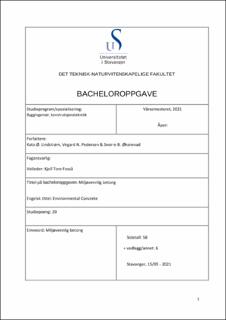Miljøvennlig betong
Bachelor thesis
Permanent lenke
https://hdl.handle.net/11250/2774347Utgivelsesdato
2021Metadata
Vis full innførselSamlinger
Sammendrag
Bacheloroppgaven vår er delt inn i 3 deler. Første del av oppgaven er en teoridel hvor vi tarfor oss hva betong er for å gi et bedre grunnlag til å forstå konklusjoner og valg senere ioppgaven.I del to har vi utført lab forsøk hvor vi har støpt totalt 24 terninger med to forskjelligeresepter. I den ene resepten bruker vi lavvarmesement med rundt 70% slagg, mens vi i denandre resepten bruker vanlig anleggssement. Begge reseptene har samme fasthetsklasse ogbestandighetsklasse ettersom vi skulle sammenligne dem i en” case” i del 3 av oppgaven. Fraresultatene kunne vi se at lavvarmebetongen hadde litt større flyt enn anleggsbetongen og attidligfastheten på lavvarmen også var lavere enn anleggsbetongen, men jo nærmere vi komdag 28 jo likere ble de to reseptene på fasthet.I den siste delen har vi lagd en” case” hvor et parkeringshus skal bli støpt, og ser på hvilkekonsekvenser eller forskjeller man ville fått om man støpte det i lavvarme betong kontravanlig anleggs betong. Vi så at prisen per kubikk var gjennomsnittlig 50 kr dyrere forlavvarmesementen, noe som ga et prisutslag på 190 000 kroner for vårt prosjekt, og i tilleggkrever lavvarmen mer utstyr og en strengere dokumentasjon, samt at fremdriften vil bli noeforsinket grunnet en tregere herdetid. Det positive vi fant ut var at ved å velgelavvarmebetongen så reduseres CO2-utslippet med det tilsvarende årlige utslippet til 100nordmenn.Foreløpig er prisen på miljøbetong litt dyrere, men i løpet av fremtiden vil miljøbetong blimer tilgjengelig og dermed billigere. Samtidig vil det komme strengere miljøkrav tilproduksjon og bruk av betong og vi tror derfor at miljøbetong vil bli viktig, og mye bruktfremover. Our bachelor thesis is divided into three parts. The first part of the thesis is a theoretical part where we look into what concrete is to provide a better basis for understanding the conclusions and choices later inthe task.In part two, we have performed lab experiments where we have cast a total of 24 dices with two differentrecipes. In one recipe, we used a low-heat cement with around 70% slag, while the second recipe uses ordinary construction cement. Both recipes have the same strength class anddurability class as we were to compare them in a "case" in part 3 of the thesis. Fromthe results we could see that the low heat concrete had a slightly greater flow than the construction concrete and that the early strength of the low heat concrete was also lower than the construction concrete, but the closer we got day 28 the more similar the two recipes were for firmness.In the last part we made a "case" where a parking garage will be cast, and we were looking at which consequences or differences one would get if we cast it in low heat concrete versusordinary construction concrete. We saw that the price per cubic meter was on average NOK 50 more expensivethe low-heat cement, which resulted in a price impact of NOK 190,000 for our project, and in additionthe low heat requires more equipment and stricter documentation, and that progress will be somewhatdelayed due to a slower curing time. The positive thing we found out was that by choosingthe low-temperature concrete, the CO2 emissions are reduced by the corresponding annual emissions to 100Norwegians.Currently, the price of environmental concrete is a little more expensive, but in the future, environmental concrete will be more accessible and thus cheaper. At the same time, there will be stricter environmental requirements regarding production and use of concrete and we therefore believe that environmental concrete will be important and widely used in the future.
